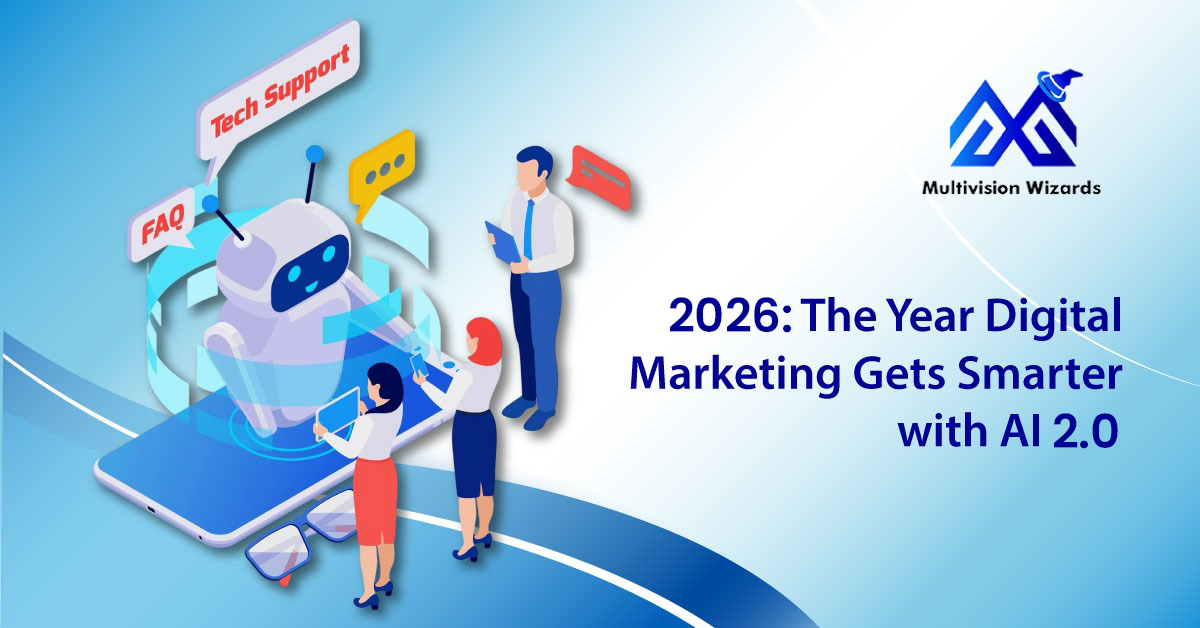2026: The Year Digital Marketing Gets Smarter with AI 2.0
Every few years, marketing takes a leap — from traditional print to digital, from websites to social media, from automation to intelligence. But 2026 marks something more profound. It’s not just another upgrade; it’s a transformation in how digital marketing thinks, acts, and evolves.
We’re now entering the age of AI 2.0, where data is no longer just collected — it’s interpreted. Campaigns are no longer built — they’re predicted. And personalization doesn’t stop at demographics — it goes deep into intent, emotion, and timing.

This is the year digital marketing gets truly smarter, blending automation, human creativity, and machine precision to create meaningful experiences that actually connect.
From Adoption to Integration: How AI Becomes the Backbone of Strategy
A few years ago, AI was treated like an external tool — something brands added to their marketing arsenal. But by 2026, it has become a silent strategist behind every campaign. The difference between a brand that uses AI and a brand that integrates AI is massive.
Adoption means using tools like Chatbots or automated email campaigns.
Integration means using AI to understand why your customers behave the way they do — and predicting what they’ll do next.
That’s the real shift of 2026. Instead of asking, “How can we automate this?” marketers are asking, “How can we make this smarter?” AI 2.0 answers that question — not by replacing human judgment, but by strengthening it with sharper insights, faster decision-making, and continuous optimization.
Understanding AI 2.0: The Smart Evolution
If AI 1.0 was about saving time, AI 2.0 is about creating value. It doesn’t just execute — it learns, adapts, and predicts.
1. Predictive Intelligence: Knowing Before It Happens
AI 2.0 uses historical and behavioral data to forecast customer actions. Imagine knowing which leads will convert before they do, or which users are about to unsubscribe so you can re-engage them in time. Marketers no longer just react — they anticipate.
2. Emotional Analytics: Marketing That Feels
2026 is the year emotions meet algorithms. AI can now detect tone, sentiment, and mood from user interactions, allowing brands to respond empathetically. Marketing messages are not just optimized for clicks — they’re optimized for connection.
3. Real-Time Optimization: The Campaign That Thinks
Traditional marketing relied on reports and post-campaign analysis. Now, campaigns optimize themselves as they run — adjusting copy, visuals, and spend automatically. It’s marketing that learns every second.
The Human Core of Smart Marketing
Technology might lead the way, but emotion still drives the journey. The most successful brands in 2026 are not those with the best AI, but those that use AI with empathy.
At Multivision Wizards, we’ve seen how automation can make marketing faster, but it’s human creativity that makes it memorable. That’s why the real strength of digital marketing in 2026 lies in balance — where data finds the audience and humans craft the message. When technology and empathy work together, marketing becomes not just effective — it becomes meaningful.
Where AI 2.0 is Transforming Digital Marketing in 2026
1. SEO Gets Predictive, Not Reactive
SEO is no longer about keywords; it’s about understanding human intent. AI-powered search engines in 2026 read context — they know what a user means, not just what they type.
Brands must now focus on:
- Writing natural, conversational content that answers questions directly.
- Using structured data so Google’s AI understands context better.
- Tracking semantic search patterns and intent-based queries.
This year, SEO becomes a dialogue, not a checklist.
2. Hyper-Personalization is the New Normal
Generic ads are fading away. AI 2.0 studies micro-behaviors — location, mood, and even interaction speed — to craft campaigns that speak directly to individuals.
In 2026, personalization means:
- Dynamic ads that change based on user activity.
- Emails written uniquely for every customer journey.
- Web experiences that adapt in real-time to behavior.
Customers no longer want to feel targeted; they want to feel understood.
3. Social Media Becomes Predictive
Social platforms in 2026 are guided by predictive analytics. They’ll show you not what’s trending now, but what will trend tomorrow. AI 2.0 helps brands:
- Identify potential viral content before it peaks.
- Schedule posts at emotionally optimal times.
- Analyze tone and response to craft better engagement.
Marketers who understand emotional timing will dominate social storytelling.
4. Voice & Visual Search: The Next SEO Frontier
Over 50% of online searches in 2026 are expected to be voice or image-based. That means optimizing for “how people speak,” not just “how they type.”
Brands that win this shift will:
- Build conversational content that aligns with natural speech.
- Invest in visual SEO using AI-tagged images and AR previews.
- Focus on local voice optimization (“best marketing agency near me”).
The future of search is multi-sensory — it listens, looks, and learns.
5. Automation That Thinks Like You
Marketing automation is becoming intuitive. Instead of pre-set rules, it learns from results and adapts autonomously. For example:
- Email systems that send at the exact moment a user is most likely to open.
- Ad campaigns that reallocate budgets in real-time for higher ROI.
- Chatbots that shift tone based on user emotion.
Automation is now intelligent enough to behave like a trained marketer — precise, quick, and responsive.
Challenges of Smarter Marketing
Every innovation brings responsibility. With AI’s growing influence, 2026 will challenge marketers to stay ethical, transparent, and human.
- Data Privacy: With stricter regulations, brands must collect and use data responsibly.
- Bias in Algorithms: Ensuring AI remains inclusive and fair.
- Human Oversight: No matter how smart tools get, decisions must remain guided by human sense and empathy.
Smart marketing is not just about knowing your customer — it’s about respecting them.
Preparing for 2026 and Beyond
Brands that want to stay relevant must start aligning now. Here’s what you should focus on:
- Revisit Your Strategy: Audit your current tools — what’s future-ready, what’s outdated?
- Invest in Data Literacy: Your team should understand not just marketing, but how data shapes it.
- Automate Wisely: Automate what saves time, not what dilutes human connection.
- Stay Human: Let technology enhance creativity, not replace it.
The next phase of digital success belongs to brands that know how to think smart and feel human.
Conclusion: 2026 Belongs to the Smarter Marketer
2026 isn’t about who uses the most advanced technology — it’s about who uses it most intelligently. The future of digital marketing lies in the seamless partnership between AI’s precision and human intuition.
At Multivision Wizards, we believe that every marketing strategy should be both data-driven and heart-led — because numbers can tell you what’s working, but only understanding can tell you why. So as AI 2.0 takes the driver’s seat, the smartest move brands can make is to steer with purpose.
If your business wants to stay ahead of the 2026 digital revolution, now’s the time to act. Let Multivision Wizards help you transform your digital marketing with intelligent strategies that combine innovation and insight.


